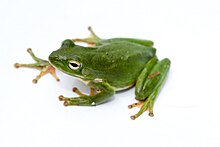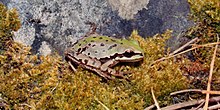
Hylidae is a wide-ranging family of frogs commonly referred to as "tree frogs and their allies". However, the hylids include a diversity of frog species, many of which do not live in trees, but are terrestrial or semiaquatic.
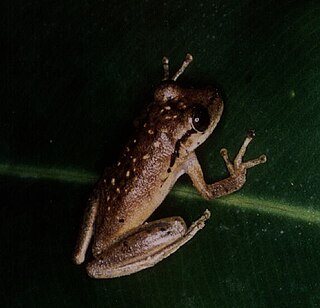
Scinax is a genus of frogs in the family Hylidae found in eastern and southern Mexico to Argentina and Uruguay, Trinidad and Tobago, and Saint Lucia. These are small to moderate-sized tree frogs, drably colored. Duellman and Wiens resurrected this genus in 1992. The name originates from the Greek word skinos, meaning quick or nimble.

Pseudacris is a genus of frogs in the family Hylidae found in North America ranging from the Pacific coastline to the Atlantic.

Spikethumb frogs are a genus (Plectrohyla) of frogs in the family Hylidae found in Central America from southern Mexico through Guatemala and northern El Salvador to central and northern Honduras. A major revision of the Hylidae moved an additional 21 species to this genus from the genus Hyla. The additional species moved to Plectrohyla were identified as the Hyla bistincta group, also called the Plectrohyla bistincta group; a separate group from the initial Plectrohyla guatemalensis group. This phylogenetic classification was later revised by moving the Plectrohyla bistincta group from the genus Plectrohyla into a new genus called Sarcohyla. Meanwhile, the guatemalensis group remained in Plectrohyla. They are called spikethumb because of the spike on their thumbs, which is called a prepollex. The genus name comes from the Greek word plēktron ("spur") and hyla.
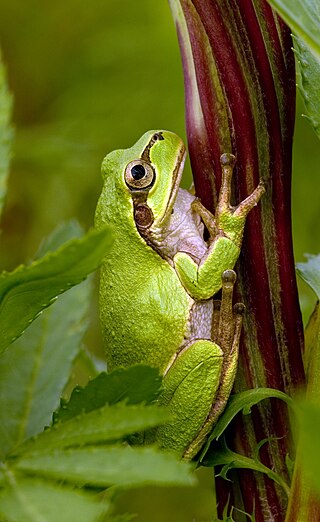
Hyla japonica, commonly known as the Japanese tree frog, is a species of anuran native to Japan, China, and Korea. H. japonica is unique in its ability to withstand extreme cold, with some individuals showing cold resistance at temperatures as low as −30 °C for up to 120 days. H. japonica are not currently facing any notable risk of extinction and are classified by the IUCN as a species of "least concern". Notably, H. japonica have been sent to space in a study that explored the effect of microgravity on H. japonica. Hyla japonica is synonymous with Dryophytes japonicus.

The Pine Barrens tree frog is a species of New World tree frog. It is becoming rare due to habitat loss.

Dendropsophus is a genus of frogs in the family Hylidae. They are distributed in Central and South America, from southern Mexico to northern Argentina and Uruguay. They are sometimes known under the common name Fitzinger neotropical treefrogs or yellow treefrogs

Dendropsophus marmoratus is a species of frog in the family Hylidae. It is found in the Amazon rainforest and montane forests in the eastern piedmont, in Bolivia, Brazil, Colombia, Ecuador, French Guiana, Guyana, Peru, Suriname, and Venezuela. Its natural habitats are subtropical or tropical moist lowland forests, intermittent freshwater marshes, and heavily degraded former forest. "Marmoratus" in Latin means "marble," perhaps referring to the dorsal coloring pattern. It is threatened by habitat loss.
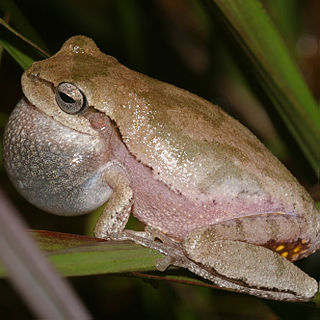
The pine woods tree frog is a species of frog in the family Hylidae, endemic to the southeastern United States.

Dryophytes immaculatus, the Chinese immaculate treefrog, is a species of frog in the family Hylidae endemic to China. The natural habitat of the species has been generally transformed into rice fields and it is threatened by habitat loss.

Wright's mountain tree frog is a species of frog in the family Hylidae found in Mexico and the United States. Its natural habitats are temperate forests, temperate grassland, rivers, and freshwater marshes. Dryophytes wrightorum has been regarded as a synonym of Dryophytes eximius, the mountain tree frog, which is listed as the state amphibian of Arizona. As presently circumscribed, Dryophytes eximius is endemic to Mexico and does not occur in Arizona. It is the state amphibian of Arizona.
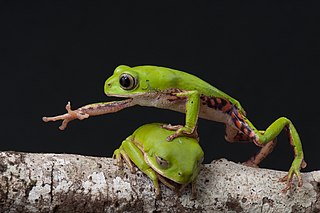
Pithecopus rohdei, also known as Rohde's leaf frog, Rohde's frog, and Mertens' leaf frog, is a species of frog in the subfamily Phyllomedusinae. The species was previously placed in the genus Phyllomedusa. The species is endemic to southeastern Brazil and occurs at elevations up to 1000 meters above sea level.

Scarthyla is a genus of tree frogs, the family Hylidae. They are found in the upper Amazon Basin of Bolivia, Peru, and Brazil and northward through Colombia and Venezuela to the Caribbean lowlands. They are sometimes known as Madre de Dios treefrogs and South American aquatic treefrogs. They are semiaquatic.

Phyllomedusinae is a subfamily of hylid tree frogs found in the Neotropics commonly called leaf frogs. Formerly, they were often considered as their own family, Phyllomedusidae.
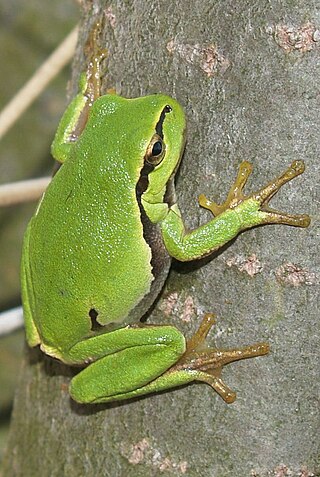
Hylinae is a large subfamily of "tree frogs", family Hylidae.

Dendropsophini is a tribe of small neotropical tree frogs in the subfamily Hylinae. They are distributed from southern Mexico, throughout Central America, and down South America to northern Argentina and Uruguay. Removed from the synonymy of Hylinae in 2016, this taxon was formerly considered its own subfamily before being reclassified as a tribe. As defined by Favovich et al. in 2005, the tribe Dendrosophini contains the members of three former subfamilies within the Hylidae prior to taxonomic rearrangement: Dendropsophinae, Pseudinae, and Scinaxinae.
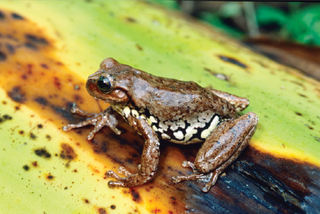
Sarcohyla is a genus of frogs in the family Hylidae. It is endemic to Mexico and is found in the montane parts of the country between Durango in the north and Guerrero in the south. These frogs typically occur in pristine habitats along streams in pine-oak woodland at elevations between 1,500 and 3,100 m above sea level. The generic name is derived from the Greek sarkodes meaning "fleshy" in combination with Hylas and refers to the thick, glandular skin characteristic of most of the species in the genus.

Rheohyla is a genus of frogs in the family Hylidae. As currently recognized, it is monotypic, containing only Rheohyla miotympanum, also known as the small-eared hyla or small-eared treefrog. However, the nominal species likely is a complex of more than one species. It is endemic to eastern and central Mexico. The generic name refers to streams, the breeding habitat of this frog. The specific name is derived from Greek meion, a diminutive prefix, together with Greek tympanon (='drum') and refers to the small tympanum.

Julianus is a genus of tree frogs in the family Hylidae. They are found in southeastern Brazil, Uruguay, and northeastern Argentina. This genus is considered poorly defined and is regarded by most to merely be a synonym of Scinax.

Dryophytes suweonensis, the Suweon treefrog or Suwon treefrog, is a species of frog in the family Hylidae endemic to the Korean Peninsula probably from the Imjin River to the Mangyeong River, south of Iksan. Its distribution and population have been assessed to be below 800 individuals and the status of the species has been updated as Endangered by the IUCN. The natural habitat of the species has been generally transformed into rice fields and it is threatened by habitat loss.


